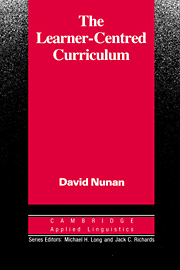Book contents
- Frontmatter
- Contents
- Series Editors' Preface
- Preface
- 1 Introduction
- 2 Curriculum Processes
- 3 Learner-Centred Curriculum Development
- 4 Pre-Course Planning Procedures
- 5 Planning Content
- 6 Methodology
- 7 Resources for a Learner-Centred Curriculum
- 8 Assessment and Evaluation
- 9 Evaluation and Professional Development
- 10 The Teacher as Curriculum Developer
- References
- Appendix
- Subject Index
- Author Index
- Frontmatter
- Contents
- Series Editors' Preface
- Preface
- 1 Introduction
- 2 Curriculum Processes
- 3 Learner-Centred Curriculum Development
- 4 Pre-Course Planning Procedures
- 5 Planning Content
- 6 Methodology
- 7 Resources for a Learner-Centred Curriculum
- 8 Assessment and Evaluation
- 9 Evaluation and Professional Development
- 10 The Teacher as Curriculum Developer
- References
- Appendix
- Subject Index
- Author Index
Summary
Introduction
There are many possible starting points for deriving course content. Rowntree suggests that these can be divided into informal (or intuitive) approaches and systematic (or analytical) approaches. He goes on to say:
Broadly speaking, the intuitive approaches are those that give us most help in thinking up possible content in the first place. The analytical techniques, on the other hand, tend to be most useful once we have generated a few ideas and are ready to see how they hang together and can be extended. In reality, of course, we are thinking both intuitively and analytically at all stages of course planning. Sometimes one predominates, however, and sometimes the other.
(Rowntree 1981:35)Examples provided by Rowntree of intuitive approaches to content specification include:
- sitting and reviewing one's own knowledge of the proposed subject
- asking other teachers and subject-matter experts
- analysing similar courses elsewhere
- reviewing textbooks aimed at students working at about the same level as ours will be
- reading more advanced books and scholarly articles on the subject
- reviewing films, radio and television tapes, newspaper and popular journal articles, etc. relating to the proposed subject
- asking prospective students what they would like to see the course include
- discussing with students their existing conceptions of, and attitudes to, the key concepts of the subject matter
- choosing books (or other source material) around which the course will be organised
- thinking of essential activities that students need to engage in as part of the course
[…]
- Type
- Chapter
- Information
- The Learner-Centred CurriculumA Study in Second Language Teaching, pp. 54 - 75Publisher: Cambridge University PressPrint publication year: 1988



